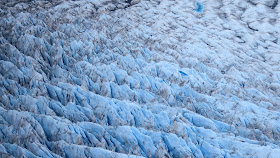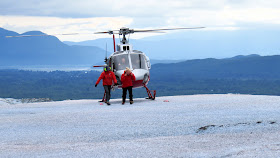To our delight, we were a go! Each of us were shod with glacier overboots to compensate for our utter lack of glacier-appropriate footwear. A large group of people were divided between four helicopters, AS-350 Eurocopters, and assigned seats based on weight and balance.
Kristy and The Bear were seated beside the pilot with me behind him and another couple in the back seat next to me. I think the woman next to me was anxious flying; I captured multiple photos of her white-knuckled grip on the back of The Bear's seat. Either that, or she was frightened by the presence of a Bear in the helicopter with us.
As evident from the sectional chart, the helicopter flight from Juneau to the Mendenhall Glacier was brief.
Although weather conditions were sufficient to fly, it was nonetheless hazy and the ceiling was certainly a weather parameter requiring attention. This was our first view of the Mendenhall from a distance. The lake at the base of the glacier, cleverly named Mendenhall Lake, was part of the glacier's path, evidence of how glacial recession has affected the area.
We seemed to skim directly below the ceiling behind two other helicopters in our cohort. I wondered what the operational cloud clearance requirements were for TEMSCO, but did not pester the pilot.
We circled near where the glacier terminated at Mendenhall Lake.
Those aren't bugs on the windscreen. We were still following the other two helicopters as we toured the glacier.
During our visit to Alaska, we came to recognize evidence of past glacial action. Mountains are not naturally this smooth; a glacier once polished these surfaces.
Glacial moraines are created where two ice flows join to create a larger glacier. The dirt and rocks carried along the edges of each tributary glacier form a stripe of debris where the ice comes together.
A distinctive quality of glacial ice is its blue color. Normally, ice appears to be white or clear. However, ice preferentially absorbs longer wavelengths (red) and passes lower wavelengths (blue). In order to appear blue, light must pass through enough ice to deplete the longer wavelengths. "Regular" ice rarely looks blue because the path length of light through it is too short. The blue tint will not develop if the ice is too thin to absorb enough from the red end of the spectrum or air bubbles in the ice block or scatter too much light. Glacial ice, on the other hand, is under so much pressure that those air bubbles are squeezed out. As a result, path lengths are long and the blue color can develop deeply.
We were really flirting with the ceiling at times. What are those cloud clearances again? Right, I was not going to ask and just ride along like a good tourist. Frankly, given where we were, the likelihood of an IFR aircraft dropping through the cloud layer on top of us was essentially zero.
Looking back toward Juneau and Mendenhall Lake.
The Bear was very actively taking photos throughout the flight.
After circling the glacier a few times, all four helicopters set down at predefined landing locations. We were instructed to march to the Alaskan flag in the center of the landing area.
Our landing spot was near the mountainside at the glacier's edge.
Once we disembarked, the previous group of glacier hikers boarded the helicopters for a trip back to Juneau. I was quite impressed with how efficiently TEMSCO conducted their tours.
It is tempting to compare the glacial "icescape" to that of a moonscape, but the glacier is far more colorful than the moon and, for as cold as it was, far warmer. Still, it is fair to say that the appearance of the glacial surface is foreign and unusual.
Open streams of glacial melt flowed over the surface, eroding away the porous upper layers of ice down to the highly compressed blue stuff. Blue glacial ice gave an illusion of depth to these streams that was not actually present. Most were quite shallow and narrower than they appeared.
It was quite cold and windy on the Mendenhall and The Bear was inadequately dressed for it (parenting fail). Fortunately, one of the tour guides had an extra coat for her.
A rite of passage for glacier visitors is to drink some of the glacial ice melt. It is clean, cold, and very refreshing. As our guide explained, you can dip your hand into the flow to sample the water, or you can lay on your belly and drink directly from the stream. The Bear tried it both ways.
The first time that The Bear tried to drink directly from the stream, the water went up her nose. After our guide (the bearded fellow above) pointed out some simple geometric facts about how faces are made, The Bear was successful, even if she looked like a little red beached whale in the process. We were glad that she could be a source of entertainment for some of the other tourists.
I was surprised that the guide let us get so close to this crevasse. The notion of falling into one of these things is terrifying.
After about thirty minutes on the glacier, our helicopter returned with a fresh load of visitors (gathered at the flag in the above photo) and we resumed our same seats in the same helicopter.
Our pilot wasted no time in returning us to Juneau International. I was impressed that the airport included an integrated seaplane base parallel to the runway. I wonder what it would cost to do the same thing at the Williamson Sodus Airport? Wish list item!
This was a highlight of our trip to Alaska. It was my third time in a helicopter in 18 years, so the flight experience was still novel. But having a true tactile experience with a glacier is a rare thing indeed for those of us living in the Lower 48.








































More excellent photos! Thanks for sharing the amazing landscapes and natural beauty.
ReplyDeleteHave I convinced you to go yet? :-)
DeleteIt's been on our bucket list. Just need to get healthy again so Mary and I can get back to traveling.
ReplyDeleteI think first up is a river boat cruise somewhere in Europe or around Italy.
I don’t think you can wrong either way, Gary.
Delete